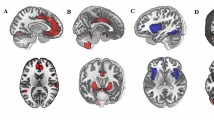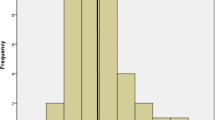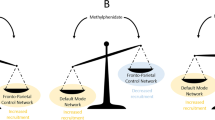Abstract
Worries preoccupy the working memory capacity in anxious individuals, thereby affecting their performance during tasks that require efficient attention regulation. According to the attentional control theory (ACT), trait anxiety affects the processing efficiency, i.e. the effort required for task performance, more than the accuracy of task performance. We investigated the relation between trait anxiety and neural response for a reasoning task in healthy subjects. Functional magnetic resonance imaging (fMRI) was carried out on 22 healthy participants and blood oxygenation level dependent (BOLD) contrast estimates were extracted from a priori regions of interest (ROIs) that were earlier implicated in reasoning (i.e., bilaterally caudate head, globus pallidus, thalamus, prefrontal cortex [rostral, dorsal and ventral regions], inferior parietal lobule and middle occipital gyrus). Controlling for the effects of age, gender, state anxiety and depressive symptoms, for equivalent levels of task performance, trait anxiety of the participants was found to be associated with an increase in task related BOLD activation in right globus pallidus, left thalamus and left middle occipital gyrus. Our results suggest a reduced processing efficiency for reasoning in high trait anxiety subjects and provides important brain–behaviour relationships with respect to sub-clinical anxiety.




Similar content being viewed by others
References
Alexander GE, Delong MR and Strick PL 1986 Parallel organization of functionally segregated circuits linking basal ganglia and cortex. Annu. Rev. Neurosci. 9 357–381
Basten U, Stelzel C and Fiebach CJ 2011 Trait anxiety modulates the neural efficiency of inhibitory control. J. Cognitive Neurosci. 23 3132–3145
Basten U, Stelzel C and Fiebach CJ 2012 Trait anxiety and the neural efficiency of manipulation in working memory. Cogn. Affect. Behav. Neurosci. 12 571–588
Beck AT, Steer RA, and Brown GK 1996 Beck depression inventory: Manual 2nd edition (San Antonio, TX: The Psychological Corporation)
Bensi L and Giusberti F 2007 Trait anxiety and reasoning under uncertainty. Pers. Individ. Dif. 43 827–838
Berggren N and Derakshan N 2012 Attentional control deficits in trait anxiety: Why you see them and why you don’t. Biol. Psychol. 92 440–446
Bishop SJ 2008 Trait anxiety and impoverished prefrontal control of attention. Nat. Neurosci. 12 92–98
Bishop SJ 2009 Trait anxiety and impoverished prefrontal control of attention. J. Neurosci. 24 10364–10368
Bishop SJ, Duncan J, Brett M and Lawlence AD 2004 Prefrontal cortical function and anxiety: controlling attention to threat related stimuli. Nat. Neurosci. 7 184–188
Carpenter PA, Just MA and Shell P 1990 What one intelligence test measures: a theoretical account of the processing in the Raven Progressive Matrices Test. Psychol. Rev. 97 404–431
Christoff K, Prabhakaran V, Dorfman J, Zhao Z, Kroger JK, Holyoak KJ and Gabrieli JD 2001 Rostrolateral prefrontal cortex involvement in relational integration during reasoning. NeuroImage 14 1136–1149
Chuderski A and Necka E 2012 The contribution of working memory to fluid reasoning: capacity, control, or both? J. Exp. Psychol. Learn. Mem. Cogn. 38 1689–710
Colom R, Jung RE and Haier RJ 2006 Distributed brain sites for the g-factor of intelligence in Neuroimage 31 1359–1365
Costa P and McCrae R 1992 Normal personality assessment in clinical practice: The NEO Personality Inventory. Psychol. Assessment 4 5–13
Darke S 1988 Effects of anxiety on inferential reasoning task performance. J. Person. Soc. Psychol. 55 499–505
Denkova E, Wong G, Dolcos S, Sung K, Wang L, Coupland N and Dolcos F 2010 The impact of anxiety-inducing distraction on cognitive performance: a combined brain imaging and personality investigation. PLOS One 5 e14150
Derakshan N and Eysenck MW 1998 Working memory capacity in high trait-anxious and repressor groups. Cogn. Emot. 12 697–713
Deshpande SN, Mathur MNL, Das SK, Bhatia T, Sharma SD and Nimgaonkar VL 1998 A Hindi version of the Diagnostic Interview for Genetic Studies. Schizophr. Bull. 24 489–493
Eickhoff S, Stephan KE, Mohlberg H, Grefkes C, Fink GR and Amunts K 2005 A new SPM toolbox for combining probabilistic cytoarchitectonic maps and functional imaging data. Neuroimage 25 1325–1335
Englert C and Bertrams A 2015 Integrating attentional control theory and the strength model of self-control. Front. Psychol. 6 1–6
Eysenck MW, Derakshan N, Santos R and Calvo MG 2007 Anxiety and cognitive performance: attentional control theory. Emotion 7 336–353
Fales CL, Barch DM, Burgess GC, Schaefer A, Mennin DS, Gray JR and Braver TS 2008 Anxiety and cognitive efficiency: Differential modulation of transient and sustained neural activity during a working memory task. Cogn. Affect. Behav. Neurosci. 8 239–253
Ferber S, Mraz R, Baker N and Graham SJ 2007 Shared and differential neural substrates of copying versus drawing: a functional magnetic resonance imaging study. Neuroreport 18 1089–1093
Friston KJ and Worksley KJ 2005 Analysis of fMRI time series revisited again. Neuroimage 2 173–181
Hahn B, Ross TJ and Stein EA 2006 Neuroanatomical dissociation between bottom-up and top-down processes of visuospatial selective attention. Neuroimage 32 842–853
Jung RE and Haier RJ 2007 The Parieto-Frontal Integration Theory (P-FIT) of intelligence: converging neuroimaging evidence. Behav. Brain. Sci. 30 135–154; discussion 154–187
Kim MJ, Gee DG, Loucks RA, Davis C and Whalen PJ 2011. Anxiety dissociates dorsal and ventral medial prefrontal cortex functional connectivity with the amygdala at rest. Cereb. Cortex. 21 1667–1673
Kroger JK, Sabb FW, Fales CL, Bookheimer SY, Cohen MS and Holyoak KJ 2002 Recruitment of anterior dorsolateral prefrontal cortex in human reasoning: a parametric study of relational complexity. Cereb. Cortex. 12 477–485
Leisman G and Melillo R 2013 The basal ganglia: motor and cognitive relationships in a clinical neurobehavioral context. Rev. Neurosci 24 9–25
Leon MR and Revelle W 1985 The effects of anxiety on analogical reasoning: a test of three theoretical models. J. Person. Soc. Psychol. 49 1302–1315
MacLeod C and Donnellan AM 1993 Individual differences in anxiety and the restriction of working memory capacity. Person. Individ. Dif. 15 163–173
Makino Y, Yokosawa K, Takeda Y and Kumada T 2004 Visual search and memory search engage extensive overlapping cerebral cortices: an fMRI study. Neuroimage 23 525–533
Markham R and Darke S 1991 The effects of anxiety on verbal and spatial task performance. Aust. J. Psychol. 43 107–111
Mayer RE 1977 Problem-solving performance with task overload: Effects of self-pacing and trait anxiety. Bull. Psychon. Soc. 9 283–286
Melrose RJ, Poulin RM and Stern CE 2007 An fMRI investigation of the role of the basal ganglia in reasoning. Brain. Res. 1142 146–158
Oldfield RC 1971 The assessment and analysis of handedness: the Edinburgh inventory. Neuropsychologia. 9 97–113
Peigneux P, Maquet P, Meulemans T, Destrebecqz A, Laureys S, Degueldre C, Delfiore G, Aerts J, Luxen A, Franck G, Van der Linden M and Cleeremans A 2000 Striatum forever, despite sequence learning variability: a random effect analysis of PET data. Hum. Brain. Mapp. 10 179–194
Prabhakaran V, Smith JA, Desmond JE, Glover GH and Gabrieli JD 1997 Neural substrates of fluid reasoning: an fMRI study of neocortical activation during performance of the Raven’s Progressive Matrices Test. Cogn. Psychol. 33 43–63
Roth JK and Courtney SM 2007 Neural system for updating object working memory from different sources: sensory stimuli or long-term memory. Neuroimage 38 617–630
Shaw P, Greenstein D, Lerch J, Clasen L, Lenroot R, Gogtay N, Evans A, Rapoport J and Giedd J 2006 Intellectual ability and cortical development in children and adolescents. Nature 440 676–679
Sigmon ST and Schartel JG 2008 Anxiety, anxiety disorders and the menstrual cycle; in Anxiety in health behaviors and physical illness (eds) MJ Zvolensky and JAJ Smits (New York: Springer) pp 181–204
Spielberger CD 1983 Manual for the state-trait anxiety inventory (Palo Alto, CA: Consulting Psychologists Press)
Tinaz S, Schendan HE, Schon K and Stern CE 2006 Evidence for the importance of basal ganglia output nuclei in semantic event sequencing: an fMRI study. Brain. Res. 1067 239–249
Tuchscherer V, Seidenberg M, Pulsipher D, Lancaster M, Guidotti L and Hermann B 2010 Extrahippocampal integrity in temporal lobe epilepsy and cognition: Thalamus and executive functioning. Epilep. Behav. 17 478–482
Wurtz RH, McAlonan K, Cavanaugh J and Berman RA 2011 Thalamic pathways for active vision. Trends. Cogn. Sci. 15 177–184
Yeh YY, Kuo BC and Liu HL 2007 The neural correlates of attention orienting in visuospatial working memory for detecting feature and conjunction changes. Brain Res. 1130 146–157
Acknowledgements
This work was supported by DRDO R&D Project No. INM 311 (4.1). The authors declare no competing financial interests. The authors thank Mr. Pawan Kumar for his assistance in data collection.
Author information
Authors and Affiliations
Corresponding author
Additional information
Communicated by ANANT BAHADUR PATEL.
Corresponding editor: Anant Bahadur Patel
Rights and permissions
About this article
Cite this article
Modi, S., Kumar, M., Nara, S. et al. Trait anxiety and neural efficiency of abstract reasoning: An fMRI investigation. J Biosci 43, 877–886 (2018). https://doi.org/10.1007/s12038-018-9800-3
Received:
Accepted:
Published:
Issue Date:
DOI: https://doi.org/10.1007/s12038-018-9800-3




